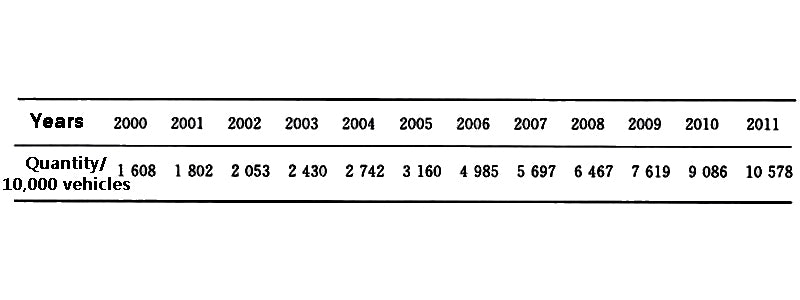
Since 2000, the world's auto industry has developed rapidly. By 2010, the global car ownership has exceeded 1 billion. It is expected that by 2030, the global car ownership will increase to 1.6 billion. In 2011, the number of cars in China exceeded 100 million, which was 6.58 times that in 2000 (Table 1). By 2020, the number of cars in China may exceed 200 million. The fast-developing automobile industry has become the main area of oil consumption in the transportation industry. In 2008, the proportion of China's vehicle fuel (gasoline and diesel) consumption in the total oil consumption has increased from 17.8% in 2000 to about 33%. Among them, gasoline consumption in China's automobiles accounts for about 86% of gasoline production, and diesel consumption accounts for about 24% of diesel production. Automobile energy saving is imminent.

Table 1 2000~2011 Vehicle Ownership
The key to energy saving in automobiles is the power system, which includes both the improvement of traditional internal combustion engine technology and the development of new energy vehicles. And new energy vehicles will undoubtedly become the inevitable trend of future automobile development. Among them, pure electric vehicles (EVs) and hybrid electric vehicles (HEVs) have gained worldwide attention due to their advantages over traditional vehicles in terms of energy efficiency and emission reduction. Electric vehicles and fuel cell electric vehicles (FCEVs) are considered to be the only zero-mission vehicles (ZEVs) that can replace internal combustion engines. The carbon monoxide, carbon dioxide, nitrogen oxides and hydrocarbons emitted by the electricity production of electric vehicles are 2%, 76%, 56% and 9% of the emissions from gasoline-powered vehicles, respectively. Using renewable energy to power electric vehicle batteries can reduce greenhouse gas emissions by 60 percent in the private vehicle sector alone. For example, with HEV, CO2 emissions can be reduced by 20% to 40%.

Development of electric vehicles such as EV and HEV
In order to promote the development of electric vehicles such as EVs and HEVs, many countries are actively taking various measures. As early as 2001, China listed the new energy vehicle research project in the "863" major scientific and technological topics during the national "Tenth Five-Year Plan" period. , the basic policy of simultaneous development of policies, regulations, technical standards and evaluation technologies”, which marks the full launch of the research and development and industrialization plan in the field of electric vehicles, and put forward the “strategy of energy saving and new energy vehicles” in the “Eleventh Five-Year Plan”. Focus on the research and development and industrialization of new energy vehicles. The United States has invested 2.5 billion US dollars to support the development of electric vehicle-related industries since 2009, and plans to deploy 1 million electric vehicles on the road by 2015. Germany has invested nearly 500 million euros in the development of electric vehicles, and it is expected that the production of electric vehicles will reach 1 million in 2020 and more than 5 million in 2030. The UK has invested 250 million pounds of rust to support the construction of the electric vehicle industry. By 2016, electric vehicles may account for 20% of the UK car market. By 2020, the total number of electric vehicles in the world will reach 11 million. The Electric Power Research Institute (EPRI) estimates that an average of 2 million electric vehicles can save 60,000 barrels of gasoline per day and reduce urban emissions by 160,000 tons per year. Based on the 200 million car ownership in China in 2020, if electric vehicles are used, 46.13 million tons of oil can be saved and 44.43 million tons of oil can be replaced, both of which are equivalent to reducing the demand for automobile oil by 32.4%.
As the most promising hydrogen fuel cell vehicle technology is difficult to break through in a short period of time, and the US government plans to terminate the clean-diesel grant program since 2012, and will stop the research and development of hydrogen fuel cell vehicles It is estimated that before 2040, vehicle energy saving will mainly rely on the development of non-hydrogen fuel EVs and HEVs.